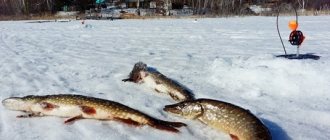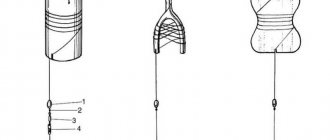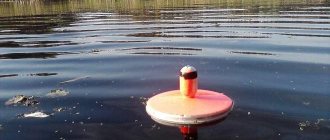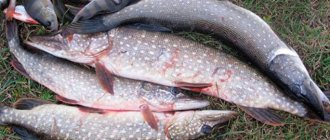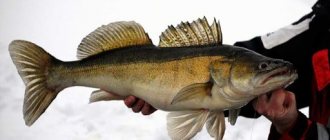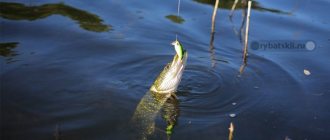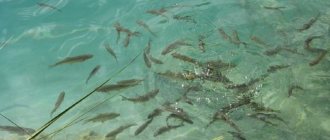Fishing place
It is impossible to give universal recommendations on choosing a place for fishing. Several factors come into play here:
- Availability of shelters;
- Availability of oxygen in water;
- Good visibility;
- An abundance of small fish that can be used to throw pike;
- Relative silence and a feeling of protection from fishermen.
In the under-ice twilight, good visibility will only be at a depth of up to 4 meters, and it is best to look for this predator in shallower areas. There is no point in fishing at a depth of more than 4-5 meters. In deeper areas, live bait should not be released completely to the bottom. The fact is that the pike often stands in the depths and looks out for the prey that is frolicking above. There it is clearly visible, especially since it displays a similar hunting style in the summer, when it hunts from below from under the thermocline boundary.
Oxygen is supplied to the water during daylight hours by plants, which by February have already finished dying and are beginning the next life cycle, preparing for summer. Both annual and perennial algae provide both good shelter and a source of oxygen. With the arrival of twilight, when they already begin to absorb oxygen from the water, the predator tries to leave overgrown areas.
The fisherman should first of all pay attention to “strong” places. Bushes, snags, submerged piles, logs, stones at the bottom - all these are natural shelters that, if they do not help the predator to completely hide, are capable of covering it at least partially. In such “strong” places, as a rule, there are enough small things.
However, pike prefers fairly large fish. It is capable of swallowing and digesting live bait equal to half its own weight, and live bait equal to one tenth is its usual prey. Therefore, it is not at all necessary that in the zone suitable for pike hunting there should be small fish, small fish. Quite often the predator approaches concentrations of large roach, silver bream, and even bream. A hundred-gram live bait, large enough, will be food for a kilogram predator. This size is the most common in the winter season of February.
Silence and a sense of security are another important factor. It’s quite difficult to catch a pike when holes are constantly being drilled around you. It is best to leave the place where the vents are placed, darken them and dust the traces with snow, which are also clearly visible from below. If you stomp a lot around the holes, this will create noticeably more light under the ice, and the predator will avoid such “suspicious” places. You should also remain quiet when landing fish.
Does pike bite in February?
Biting activity depends on weather conditions. Severe frosts usually persist until the middle of the month, and the ice crust becomes thicker. Pike lives at great depths and almost never leaves their camp site. She is inactive and inactive, “hunting” in a small water area. In winter, the toothy fish has a weakened metabolism, so small fish are enough to satiate it. After “lunch,” the pike falls into a stupor, digesting its prey. Therefore, pike in the first ten days of the month is a rare occurrence, especially in reservoirs completely covered with ice.
The situation changes in the middle/end of the month. The decline of frosts and an increase in daytime temperatures, the gradual thawing of ice lead to the spotted fish “waking up”. Now it is leaving the depths, moving to the coastline and tributaries of rivers - places where ice melts faster and fresh water carries life-giving oxygen. Also, at the end of winter/beginning of spring, pre-spawning migrations begin - this makes the bite even more successful.
Attention! The behavior of pike depends on the conditions of a particular region. In the North, the entire month of February is a period of deaf biting. In the middle zone, the spotted one begins to become active only towards the end of the month. In the South, the bite becomes more successful already in mid-February.
The first to wake up are small individuals - grass pikes. They are found in the coastal zone before anyone else. Large specimens “sway” for a long time and slowly. The small fish are already actively responding to bait, and the pike “patriarchs” are just emerging from their hiding places.
About
Selection of girder equipment. How to make a zherlitsa with your own hands.
Zherlitsa is the main and most common way of catching pike in winter. The best design for a pike trap is the traditional one, with a round plate covering the hole and a signaling flag. This design allows you not only to use all kinds of equipment, flexible settings, change the sensitivity of the equipment, but also to track the bite.
Monitoring the bite on a girder in winter fishing is one of the keys to success. Pike behave cautiously in winter and take their prey slowly. After she grabs the bait crosswise, she turns it around in her mouth with its tail facing outward and swallows it from the head. He also swallows slowly, not like in the summer. She has enough time to feel the hook, the rough wire leader, prick and spit out the bait. Therefore, the fisherman must run up in time and make a hook. In this case, the fish will not come off.
However, girders designed for self-notching are often used. These are easy to make yourself, while ordinary flags with flags are easier to buy. The simplest girder is a stick laid across the hole, to which is tied a piece of thick wire and then a fishing line with live bait equipment. The wire is needed so that when the hole freezes, it can be cleaned with an pick, a hatchet or a knife without fear of cutting the line.
Regarding the equipment of the girder, it must be said that it should be as simple as possible. Be sure to install a leash that the pike cannot bite through. It is best to use flexible ones made of leash material, but at worst, ordinary wire ones will do. The hook is usually set with two treble hooks, large enough to cut the pike's mouth through the cartilage. With two hooks, she practically cannot pick off live bait with impunity; there will be fewer fish runs and empty bites than with one.
It is best to mount the fish by the edge of the dorsal fin, anal fin, or lips, avoiding damaging large bones or organs, but so that it cannot be torn off. You should not use tackle that passes through the gills and supposedly does not injure live bait. In fact, live bait runs much less on them than when baited by the fin, since damage to the gills is more painful for the fish than damage to the sponges or fin, and it also interferes with breathing.
Fishing tactics
It is very important to choose the right fishing tactics, which will allow you to catch pike on girders in February. Much in this matter depends on the experience and skills of the fisherman. Seasoned hunters of the toothy predator know its habits well and have in their arsenal various tricks and techniques specially invented for specific fishing conditions.
The main task of the fisherman is to correctly place the girders in the selected water area. Depending on the type of reservoir, there may be some nuances:
- When fishing a river pit, gear is placed at the entrance and exit, as well as along the side dumps. It is advisable to install several live baits directly in the middle of the pit.
- When fishing in various oxbow lakes and backwaters, girders are placed along the edge on the border with coastal aquatic vegetation. A couple of pieces should be installed in the deepest places, a few more on local hills or near individual shelters.
- On reaches and locations with a relatively calm bottom topography without pronounced anomalies, the girders are placed evenly.
If an angler caught a pike in a specific area of the water area and there were several more “shots” of the fishing flags, while in other areas there was complete silence, then it is advisable to concentrate all the gear on the most promising location.
In winter, you should not frequently re-check the pike trap or change its location. Having drilled a hole and installed the tackle there, you need to let the situation calm down. If there is no bite within the first hour, then the live bait is removed, the condition of the bait is checked and, if necessary, moved to another point.
In February, it is best to place live bait 50 cm from the bottom. This is the most optimal distance allowing for qualitative exploration of the near-bottom horizon. Several girders are placed at half-water. If the pike takes in thick water, then all the gear is reconfigured.
Other fishing methods
In addition to the girdle, there are many other ways to catch pike.
On the crab
For the European part of Russia, the method is quite exotic. However, it is widely used in the Far East and Siberia. Crab is a special bait like a balancer, but flattened on top and having three or four hooks extending in different directions. The crab's game is very unique; it persists throughout the current. They are caught at shallow depths, up to two meters, in places where the current is not too fast.
To the balancer
Fishing with a balance beam is more familiar to fishermen and is practiced both abroad and in Russia. The pike balancer should have a fairly sharp stroke. Even in shallow water, they use large mass balancers that move away, quickly return, and some even make a double or triple loop. The optimal shape of the balancer is with a flat head, “fin” type or similar. Often they use a balancer with a metal tail, because the pike takes the bait quite sharply and bites off the tail.
The balancer must be inserted through the fastener and a strong leash must be used. The fishing line used is one that can be used to easily get a pike into the hole.
This is usually much more difficult than with perch because the fish is long. If the fishing line is thin, then winding it, and even with a wide balancer in the mouth, will be difficult, and there will be a lot of slips. A hook that you have to constantly carry with you, as well as a 150 mm ice auger, saves you from derailments.
For the spinner
Nowadays, lure fishing is rarely used, since in terms of effectiveness for pike, lures are inferior to balancers, rattlins and other modern lures. However, if you want to “remember the old days,” you can fish with summer spoons, playing with them like glider spoons. The “shtorleg” and “rapala” spinners perform well in this capacity; they have a center of gravity in the center of the resistance area, play well when falling and rarely get caught in the fishing line when tossing.
Pike fishing methods in January
Zherlitsy are the most promising way to catch pike in January. If warming is observed, then this predator can be successfully caught by trolling, using balancers and vertical spoons. Let's take a closer look at both methods.
Fishing with girders
The zherlitsa is a mechanism that, using a flag, signals the fisherman about a bite. This type of tackle consists of a platform that is installed above the hole and ensures the stability of the entire structure, as well as shading. A tripod with a coil and a flag on a flexible metal plate is mounted on the platform. The flag is bent under the reel, after a bite the reel unwinds and the flag unbends and rises to the top.
To fish with girders, you need live bait; it is better to stock up on them in advance, since in January you may not be able to catch it at the right time. Live bait is attached to a double or triple hook; this is most often done by the upper fin of the fish, but there are many other methods. The hook itself is equipped with a leash so that the pike does not bite the fishing line, and then comes the main fishing line with a diameter of 0.30-0.35 mm. Often an additional sinker is placed in front of the leash, which helps to quickly deliver the bait to the desired depth and keep it there.
To find out in which layers of water our future prey (pike) is located, it is better to initially place them from the shore to the middle of the reservoir. Holes are drilled at intervals of 10-12 mm and then vents are installed. Further, in order to search for our predator, the girders can be reinstalled in other promising places.
More information about fishing with girders
Fishing with lures
Although in January spinners or balancers are less attractive than live bait, with the advent of short-term thaws their successful use is possible. To do this, take a winter spinning rod with guide rings and a multiplier or spinning reel, a strong fishing line from 0.25 mm, a fluorocarbon leash and bait itself, which are winter spinners and balancers. A guard is not necessary; the pike attacks with sufficient audacity, so the blow will be confidently felt in the angler’s hand.
Fishing with lures requires frequent drilling of holes and constant movement of the angler around the reservoir. It is recommended to drill both in shallows, near snags and bushes, and at great depths; the main thing is not to be lazy in doing this, since constant activity will be the key to success in our case.
Lures of large specimens from 4 to 8 cm are recommended; pike are unlikely to want to waste expensive energy in January on various little things.
More about lure fishing
Fishing process
Meanwhile, the first flag on the farthest pier lit up. The comrade, as the owner of the gear, immediately hurried to her. The reel of fishing line froze motionless. The comrade carefully removes the rod to the side, having first released a little fishing line. First, second interception... A sharp hook. Got it! He says that the specimen is small, there is no need to run for the hook. Meanwhile, closer to the hole, the resistance increased noticeably. It was clearly visible that the fish did not enter the hole (the opponent was lively, the ice was thick, and the diameter of the hole was only 110 mm). After the fifth time, the pike finally appeared to be a little over a kilogram. There is an initiative!
And very soon, on the girder, located about thirty meters from the one where the bite had just been, the flag straightened out once again. The gear belonged to neighbors who, apparently out of hopelessness, hid in their car and came out extremely reluctantly.
We chose the so-called “bumps” as our fishing spot. It is not entirely clear how such a relief was formed, but the depth varied all the time from 2 to 4 meters. And so it was approximately on an area of 200x200 meters. As I already said, it was possible to at least somehow navigate the area thanks to summer boat fishing. Coincidentally or not, it was precisely at that point (remembered from landmarks on the shore) where I caught a 2 kg pike perch last spring that another operation took place on my gear
I carefully lift the line, clear the hole of ice, and only then begin to select the fishing line. After making several interceptions, I realized that there was no one to hook. This is true.
The reasons for empty bites can be different, and it will probably never be possible to prevent them all, but it’s worth keeping the following in mind. The main reason for an empty bite is a flaw in the tackle noticed by the pike. This could be an excessively heavy load, a large hook, a rough leash, a thick and hard main line, or a tight line coming off. In addition, there is noise and fuss over the hole, careless picking up of slack line before hooking and, finally, line frozen into the ice. It was the last reason that was now the most real. Most likely, the pike, having bitten the bait, was about to turn it around in its mouth, but the treacherous crust of ice in the hole stopped the fishing line and “told” it that the bait was on a leash.
Meanwhile, today's statistics have rapidly begun to change towards an increase in the number of missed bites. And if the first two attacks brought a pike each, then for an hour there were only idle approaches. And one of them especially tickled my nerves and imagination. It was like that.
In order not to make noise right next to the girders, we went to the shore to catch perch with a jig. The first fish were caught on bloodworms, and then, for fun, they attached a worm made of “edible” silicone, which was successfully used for fishing in the summer. It was noticeably worse than on bloodworms, but the perch also pecked at the “edible” and was even caught (I just had to give it extra time). At the same time, they became so carried away with fishing that they forgot about the girders.
The first comrade, without taking his eyes off the nod, asked if the zherlitsa was “on fire”? I look up. Of course it's on fire! And, as usually happens, the farthest vent worked. We rushed towards her. A lot of fishing line has been wound. The comrade (this is his zherlitsa) carefully picks up the slack and, finally, sweeps the hook. I'm watching him closely. I see with trepidation how, after hooking, he immediately gives the line back. Is it really a “crocodile”? I know that there are pike in the tens, pike perch in the fives, and catfish in the thirties. But there was a banal catch.
Here’s another lesson for a beginning girder fisher: if you come to fish with girders, then fish only with them, leave the jigs and balancers at home. Perhaps, in our case, full “combat readiness” would have prevented the fish from going into the snags.

